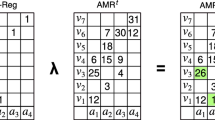Abstract
We model the mechanism of the retrieval of associations from the associative memory during visual scene analysis. During the analysis of the visual scene, the retrieval phase of the associative memory is divided into two stages: the attention stage and the binding stage. In the attention stage, an attention window selects patterns representing objects for further access. In the binding stage, the selected patterns form an address vector. The behavior of the model is demonstrated by theoretical analysis and empirical experiment.








Similar content being viewed by others
References
Allport A. Visual attention. In: Posner M, editor. Foundations of cognitive science. Cambridge: The MIT Press; 1989. p. 631–82.
Anderson JA. An introduction to neural networks. Cambridge: The MIT Press; 1995.
Braitenberg V, Schüz A. The anatomy of the cortex. Statistics and geometry. New York: Springer; 1991.
Corbetta M, Patel G, Shulman GL. The reorienting system of the human brain: from environment to theory of mind. Neuron 2008;58:306–24.
Crick F. Function of the thalamic reticular complex: the searchlight hypothesis. In: Baars BJ, Banks WP, Newman J, editors. Essential sources in the scientific study of consciousness. Cambridge: MIT Press; 2003.
Damasio AR, Damasio H. Cortical systems for retrieval of concrete knowledge: the convergence zone farmework. In: Koch C, Davis JL, editors. Large-scale neural theories of the brain, chap. 3. Cambridge: The MIT Press; 1994. p. 61–74.
Downing C, Oinker S. The spatial structure of visual attention. In: Posner M, Marin O, editors. Attention and performance XI. Hillsdale, NJ: Erlbaum; 1985. p. 171–87.
Fransén E. Biophysical simulation of cortical associative memory. PhD thesis, Stockhokms Universitet, Department of Numerical Analysis and Computing Science Royal Institute of Technology, S-100 44 Stockholm, Sweden; 1996.
Gary C, Singer W. Stimulus specific neural oscillations in orientation columns of cat visual cortex. PNAS 1989;86:1698–702.
Gross CG, Mishkin M. The neural basis of stimulus equivalence across retinal translation. In: Harnad S, Dorty R, Jaynes J, Goldstein L, Krauthamer G, editors. Lateralization in the nervous system. New York: Academic Press; 1977.
Hecht-Nielsen R. Neurocomputing. Reading: Addison-Wesley; 1989.
Kosko B. Neural networks and fuzzy systems: a dynamical systems approach to machine intelligence. Englewood: Prentice-Hall; 1992.
Kosslyn SM. Image and brain, the resolution of the imagery debate. Cambridge: The MIT Press; 1994.
McClelland J, Rumelhart D. Distributed memory and the representation of general and specific memory. J Exp Psychol Gen 1985;114:159–88.
Osherson DN. New axioms for the contrast model of similarity. J Math Psychol 1987;31:93–103.
Palm G. Neural assemblies, an alternative approach to artificial intelligence. New York: Springer; 1982.
Palm G. Assoziatives Gedächtnis und Gehirntheorie. In: Gehirn und Kognition. Spektrum der Wissenschaft; 1990. p. 164–74.
Palm G, Schwenker F, Sommer F, Strey A. Neural associative memories. In: Krikelis A, Weems C (ed) Associative processing and processors. New York: IEEE Press; 1997. p. 307–25.
Posner MI, Raichle ME. Images of mind. New York: Scientific American Library; 1994.
Singer W, Gary C. Visual feature integration and the temporal correlation hypothesis. Annu Rev Neurosci 1995;18:555–86.
Steinbuch K. Die Lernmatrix. Kybernetik 1961;1:36–45.
Triesmann A, Gormican S. Feature analysis in early vision. Psyhol Rev 1988;95:15–30.
Tversky A. Feature of similarity. Psychol Rev 1977;84:327–352.
Wennekers T. Synchronisation und Assoziation in Neuronalen Netzen. Aachen: Shaker Verlag; 1999.
Wichert A. Sub-symbols and icons. Cognit Comput 2009;1(4):342–47.
Wichert A, Pereira JD, Carreira P. Visual search light model for mental problem solving. Neurocomputing 2008. doi:10.1016/j.neucom.2007.08.019.
Acknowledgments
This work was supported by Fundao para a Cencia e Tecnologia (FCT) (INESC-ID multiannual funding) through the PIDDAC Program funds.
Author information
Authors and Affiliations
Corresponding author
Rights and permissions
About this article
Cite this article
Wichert, A. The Role of Attention in the Context of Associative Memory. Cogn Comput 3, 311–320 (2011). https://doi.org/10.1007/s12559-010-9064-1
Received:
Accepted:
Published:
Issue Date:
DOI: https://doi.org/10.1007/s12559-010-9064-1




